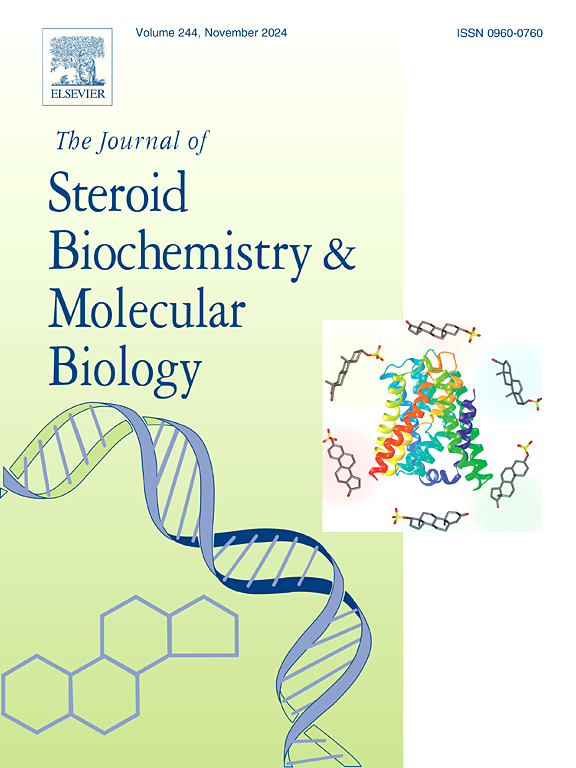Secosteroid – 1,3,4-oxadiazole hybrids: Synthesis and evaluation of their activity against hormone-dependent breast cancer cells
IF 2.5
2区 生物学
Q3 BIOCHEMISTRY & MOLECULAR BIOLOGY
Journal of Steroid Biochemistry and Molecular Biology
Pub Date : 2025-03-29
DOI:10.1016/j.jsbmb.2025.106745
引用次数: 0
Abstract
This study focused on the synthesis of secosteroids with good antiproliferative properties against hormone-dependent breast cancer. A straightforward and efficient method for synthesizing secosteroid – 1,3,4-oxadiazole hybrids was developed starting from 13α-hydroxy-3-methoxy-13,17-secoestra-1,3,5(10)-trien-17-oic acid hydrazide. The cyclization of hydrazide moiety with CS2 into 1,3,4-oxadiazole-2(3H)-thione fragment followed by sulfur alkylation resulted in the formation of various secosteroid – 2-mercapto-1,3,4-oxadiazole hybrids. These novel compounds were evaluated for their antiproliferative activity against the hormone-dependent human breast cancer cell line MCF-7. Among the synthesized hybrids, compounds 3i, 3o, and 3q displayed notable antiproliferative effects, with IC50 values ranging from 6.5 to 8.9 µM, comparable to the reference drug cisplatin. Furthermore, compound 3i showed minimal toxicity toward non-cancerous hFB-hTERT fibroblasts, indicating high selectivity. Compounds 3o and 3q exhibited antiestrogenic activity. Additionally, their effects on PARP and Bcl-2 suggest a pro-apoptotic mechanism of action. These findings highlight the potential of secosteroidal hybrids as promising candidates for the development of new anti-breast cancer agents targeting ERα and apoptosis pathways.
secosteroids - 1,3,4- oxadiazole杂合物:合成及对激素依赖性乳腺癌细胞的活性评价。
本研究的重点是合成对激素依赖性乳腺癌具有良好抗增殖特性的secosteroids。以13α-羟基-3-甲氧基-13,17-二甲醚-1,3,5(10)-三烯-17-羟基酸肼为起始原料,建立了一种简单高效的合成第二甾体- 1,3,4-恶二唑杂化物的方法。酰肼部分与CS2环化成1,3,4-恶二唑-2(3H)-硫酮片段,然后再进行硫烷基化反应,形成了各种仲甾-2 -巯基-1,3,4-恶二唑杂化物。这些新化合物对激素依赖性人乳腺癌细胞系MCF-7的抗增殖活性进行了评价。在所合成的杂合体中,化合物3i、30、3q表现出显著的抗增殖作用,IC50值在6.5 ~ 8.9µM之间,与参比药物顺铂相当。此外,化合物3i对非癌性hFB-hTERT成纤维细胞的毒性很小,表明具有高选择性。化合物30和3q具有抗雌激素活性。此外,它们对PARP和Bcl-2的作用提示其促凋亡机制。这些发现突出了类固醇杂交体作为开发靶向ERα和细胞凋亡途径的新型抗乳腺癌药物的潜力。
本文章由计算机程序翻译,如有差异,请以英文原文为准。
求助全文
约1分钟内获得全文
求助全文
来源期刊
CiteScore
8.60
自引率
2.40%
发文量
113
审稿时长
46 days
期刊介绍:
The Journal of Steroid Biochemistry and Molecular Biology is devoted to new experimental and theoretical developments in areas related to steroids including vitamin D, lipids and their metabolomics. The Journal publishes a variety of contributions, including original articles, general and focused reviews, and rapid communications (brief articles of particular interest and clear novelty). Selected cutting-edge topics will be addressed in Special Issues managed by Guest Editors. Special Issues will contain both commissioned reviews and original research papers to provide comprehensive coverage of specific topics, and all submissions will undergo rigorous peer-review prior to publication.

 求助内容:
求助内容: 应助结果提醒方式:
应助结果提醒方式:


